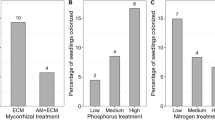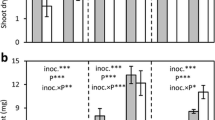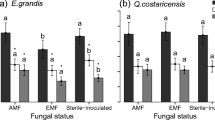Abstract
Ectomycorrhizal fungi contribute to the nutrition of many woody plants, including those in the Pinaceae family. Loblolly pine (Pinus taeda L.), a native species of the Southeastern USA, can be colonized by multiple species of ectomycorrhizal fungi. The role of these symbionts in P. taeda potassium (K+) nutrition has not been previously investigated. Here, we assessed the contribution of four ectomycorrhizal fungi, Hebeloma cylindrosporum, Paxillus ammoniavirescens, Laccaria bicolor, and Suillus cothurnatus, in P. taeda K+ acquisition under different external K+ availabilities. Using a custom-made two-compartment system, P. taeda seedlings were inoculated with one of the four fungi, or kept non-colonized, and grown under K+-limited or -sufficient conditions for 8 weeks. Only the fungi had access to separate compartments in which rubidium, an analog tracer for K+, was supplied before harvest. Resulting effects of the fungi were recorded, including root colonization, biomass, and nutrient concentrations. We also analyzed the fungal performance in axenic conditions under varying supply of K+ and sodium. Our study revealed that these four ectomycorrhizal fungi are differentially affected by external K+ and sodium variations, that they are not able to provide similar benefits to the host P. taeda in our growing conditions, and that rubidium may be used with some limitations to estimate K+ transport from ectomycorrhizal fungi to colonized plants.








Similar content being viewed by others
References
Albaugh T, Allen HL, Fox TR et al (2009) Opportunities for fertilization of Loblolly pine in the Sandhills of the Southeastern United States. South J Appl for 33:129–136. https://doi.org/10.1093/sjaf/33.3.129
Allen GJ, Chu SP, Harrington CL et al (2001) A defined range of guard cell calcium oscillation parameters encodes stomatal movements. Nature 411:1053–1057. https://doi.org/10.1038/35082575
Ashe WW (1915) Loblolly, or North Carolina pine. Edwards & Broughton Printing Co., state printers and binders, Raleigh
Asher C, Ozanne P (1967) Growth and potassium content of plants in solution cultures maintained at constant potassium concentrations. Soil Sci 103:155–161
Ashley MK, Grant M, Grabov A (2006) Plant responses to potassium deficiencies: a role for potassium transport proteins. J Exp Bot 57:425–436. https://doi.org/10.1093/jxb/erj034
Assaha DVM, Ueda A, Saneoka H, Al-Yahyai R, Yaish MW (2017) The role of Na+ and K+ transporters in salt stress adaptation in glycophytes. Front Physiol 8:509. https://doi.org/10.3389/fphys.2017.00509
Becquer A, Guerrero-Galán C, Eibensteiner JL et al (2019) The ectomycorrhizal contribution to tree nutrition. Adv Bot Res 89:77–126. https://doi.org/10.1016/BS.ABR.2018.11.003
Bengtson GW (1976) Comparative response of four Southern pine species to fertilization: Effects of P, NP, and NPKMgS applied at planting. For Sci 22:487–494. https://doi.org/10.1093/forestscience/22.4.487
Benito B, Haro R, Amtmann A et al (2014) The twins K+ and Na+ in plants. J Plant Physiol 171:723–731. https://doi.org/10.1016/j.jplph.2013.10.014
Carlson CA, Fox TR, Allen HL et al (2014) Growth responses of Loblolly pine in the Southeast United States to midrotation applications of nitrogen, phosphorus, potassium, and micronutrients. For Sci 60:157–169. https://doi.org/10.5849/forsci.12-158
Casieri L, Lahmidi NA, Doidy J et al (2013) Biotrophic transportome in mutualistic plant – fungal interactions. Mycorrhiza 23:597–625. https://doi.org/10.1007/s00572-013-0496-9
Debaud JC, Gay G (1987) In vitro fruiting under controlled conditions of the ectomycorrhizal fungus Hebeloma cylindrosporum associated with Pinus pinaster. New Phytol 105:429–435. https://doi.org/10.1111/j.1469-8137.1987.tb00880.x
Dessì P, Contu M (1999) Paxillus ammoniavirescens spec. nov. with notes on the genus Paxillus in Sardinia. In: Micol Veg Medit 13(2):123
Domínguez Núñez JA, Planelles González R, Rodríguez Barreal JA, Saiz de Omeñaca González JA (2007) The effect of Tuber melanosporum Vitt. mycorrhization on growth, nutrition, and water relations of Quercus petraea Liebl., Quercus faginea Lamk., and Pinus halepensis Mill. seedlings. New For 35:159. https://doi.org/10.1007/s11056-007-9069-0
Domínguez Núñez JA, Serrano JS, Barreal JAR, González JAS de O (2006) The influence of mycorrhization with Tuber melanosporum in the afforestation of a Mediterranean site with Quercus ilex and Quercus faginea. For Ecol Manage 231:226–233. https://doi.org/10.1016/j.foreco.2006.05.052
Estrada B, Aroca R, Maathuis FJM et al (2013) Arbuscular mycorrhizal fungi native from a Mediterranean saline area enhance maize tolerance to salinity through improved ion homeostasis. Plant Cell Environ 36:1771–1782. https://doi.org/10.1111/pce.12082
Fromm J (2010) Wood formation of trees in relation to potassium and calcium nutrition. Tree Physiol 30:1140–1147. https://doi.org/10.1093/treephys/tpq024
Garcia K, Chasman D, Roy S, Ane J-M (2017) Physiological responses and gene co-expression network of mycorrhizal roots under K+ deprivation. Plant Physiol 173:1811–1823. https://doi.org/10.1104/pp.16.01959
Garcia K, Delteil A, Conéjéro G et al (2014) Potassium nutrition of ectomycorrhizal Pinus pinaster: overexpression of the Hebeloma cylindrosporum HcTrk1 transporter affects the translocation of both K(+) and phosphorus in the host plant. New Phytol 201:951–960. https://doi.org/10.1111/nph.12603
Garcia K, Doidy J, Zimmermann SD et al (2016) Take a trip through the plant and fungal transportome of mycorrhiza. Trends Plant Sci 21:937–950. https://doi.org/10.1016/j.tplants.2016.07.010
Garcia K, Guerrero-Galán C, Frank HER et al (2020) Fungal Shaker-like channels beyond cellular K+ homeostasis: a role in ectomycorrhizal symbiosis between Hebeloma cylindrosporum and Pinus pinaster. PLoS One 15:e0242739
Garcia K, Zimmermann SD (2014) The role of mycorrhizal associations in plant potassium nutrition. Front Plant Sci 5:1–9. https://doi.org/10.3389/fpls.2014.00337
Guerrero-Galán C, Calvo-Polanco M, Zimmermann SD (2019) Ectomycorrhizal symbiosis helps plants to challenge salt stress conditions. Mycorrhiza. https://doi.org/10.1007/s00572-019-00894-2
Guerrero-Galán C, Garcia K, Houdinet G, Zimmermann SD (2018a) HcTOK1 participates in the maintenance of K+ homeostasis in the ectomycorrhizal fungus Hebeloma cylindrosporum, which is essential for the symbiotic K+ nutrition of Pinus pinaster. Plant Signal Behav 1–3. https://doi.org/10.1080/15592324.2018.1480845
Guerrero-Galán C, Houdinet G, Calvo-Polanco M et al (2018b) The role of plant transporters in mycorrhizal symbioses. Adv Bot Res 87:303–342. https://doi.org/10.1016/BS.ABR.2018.09.012
Guerrero-Galán C, Delteil A, Garcia K et al (2018c) Plant potassium nutrition in ectomycorrhizal symbiosis: properties and roles of the three fungal TOK potassium channels in Hebeloma cylindrosporum. Environ Microbiol 20:1873–1887. https://doi.org/10.1111/1462-2920.14122
Hafsi C, Debez A, Abdelly C (2014) Potassium deficiency in plants: effects and signaling cascades. Acta Physiol Plant 36:1055–1070. https://doi.org/10.1007/s11738-014-1491-2
Hawkes CV, Casper BB (2002) Lateral root function and root overlap among mycorrhizal and nonmycorrhizal herbs in a Florida shrubland, measured using rubidium as a nutrient analog. Am J Bot 89:1289–1294. https://doi.org/10.3732/ajb.89.8.1289
Jokela EJ, Martin TA, Vogel JG (2010) Twenty-five years of intensive forest management with Southern pines: Important lessons learned. J for 108:338–347. https://doi.org/10.1093/jof/108.7.338
Li B, McKeand S, Weir R (1999) Tree improvement and sustainable forestry—impact of two cycles of loblolly pine breeding in the U.S.A. Int J for Genet 6:229–234
Liao H-L, Chen Y, Vilgalys R (2016) Metatranscriptomic study of common and host-specific patterns of gene expression between pines and their symbiotic ectomycorrhizal fungi in the genus Suillus. PLOS Genet 12:e1006348
Marschner H, Schimansky C (1971) Suitability of using rubidium-86 as a tracer for potassium in studying potassium uptake by barley plants. Zeitschrift Für Pflanzenernährung Und Bodenkd 128:129–143. https://doi.org/10.1002/jpln.19711280206
Martin F, Duplessis S, Ditengou F et al (2001) Developmental cross talking in the ectomycorrhizal symbiosis: signals and communication genes. New Phytol 151:145–154. https://doi.org/10.1046/j.1469-8137.2001.00169.x
McKeand SE, Jokela EJ, Huber DA et al (2006) Performance of improved genotypes of loblolly pine across different soils, climates, and silvicultural inputs. For Ecol Manage 227:178–184. https://doi.org/10.1016/j.foreco.2006.02.016
Nehls U, Plassard C (2018) Nitrogen and phosphate metabolism in ectomycorrhizas. New Phytol 220:1047–1058. https://doi.org/10.1111/nph.15257
Orton PD (1960) New check list of British agarics and boleti: part III. Notes on genera and species in the list. Trans Br Mycol Soc 43:159–384. https://doi.org/10.1016/S0007-1536(60)80065-4
Peng L, Huang J, Yuan L (2020) Biological mobilization of potassium from soil by thirteen Suillus species and ectomycorrhizal Pinus massoniana Lamb. seedlings. Eur J Soil Sci 71:740–751. https://doi.org/10.1111/ejss.12898
Plassard C, Becquer A, Garcia K (2019) Phosphorus transport in mycorrhiza: How far are we? Trends Plant Sci 24:794–801. https://doi.org/10.1016/j.tplants.2019.06.004
Plassard C, Dell B (2010) Phosphorus nutrition of mycorrhizal trees. Tree Physiol 30:1129–1139. https://doi.org/10.1093/treephys/tpq063
Pollastri S, Savvides A, Pesando M et al (2018) Impact of two arbuscular mycorrhizal fungi on Arundo donax L. response to salt stress. Planta 247:573–585. https://doi.org/10.1007/s00425-017-2808-3
Polley LD, Hopkins JW (1979) Rubidium (potassium) uptake by Arabidopsis: a comparison of uptake by cells in suspension culture and by roots of intact seedlings. Plant Physiol 64:374–378. https://doi.org/10.1104/pp.64.3.374
Ragel P, Raddatz N, Leidi EO et al (2019) Regulation of K(+) nutrition in plants. Front Plant Sci 10:281. https://doi.org/10.3389/fpls.2019.00281
Rao PS, Niederpruem DJ (1969) Carbohydrate metabolism during morphogenesis of Coprinus lagopus (sensu Buller). J Bacteriol 100:1222–1228. https://doi.org/10.1128/JB.100.3.1222-1228.1969
Rygiewicz PT, Bledsoe CS (1984) Mycorrhizal effects on potassium fluxes by northwest coniferous seedlings. Plant Physiol 76:918–923
Schultz RP (1999) Loblolly—the pine for the twenty-first century. New for 17:71–88. https://doi.org/10.1023/A:1006533212151
Shoulders E, Tiarks AE (1990) Nine-year response of thinned slash pine to nitrogen, phosphorus, and potassium. Soil Sci Soc Am J 54:234–237. https://doi.org/10.2136/sssaj1990.03615995005400010037x
Singer R (1945) The Boletineae of Florida with notes on extralimital species. II. The Boletaceae (Gyroporoideae). Farlowia. 2 (2): 223–303. https://doi.org/10.2307/2421647
Smith SE, Read D (2008) Mycorrhizal symbiosis, 3rd edn. Academic Press, London
Sun Q, Fu Z, Finlay R, Lian B (2019) Transcriptome analysis provides novel insights into the capacity of the ectomycorrhizal fungus Amanita pantherina to weather K-containing feldspar and apatite. Appl Environ Microbiol 85:e00719-e819. https://doi.org/10.1128/AEM.00719-19
Tang R-J, Wang C, Li K, Luan S (2020) The CBL–CIPK calcium signaling network: unified paradigm from 20 years of discoveries. Trends Plant Sci 25:604–617. https://doi.org/10.1016/j.tplants.2020.01.009
Tyler G (1997) Influence of acidity and potassium saturation on plant uptake of indigenous soil rubidium. Environ Exp Bot 38:181–186. https://doi.org/10.1016/S0098-8472(97)00012-9
Vallejo AJ, Peralta ML, Santa-Maria GE (2005) Expression of potassium-transporter coding genes, and kinetics of rubidium uptake, along a longitudinal root axis. Plant Cell Environ 28:850–862. https://doi.org/10.1111/j.1365-3040.2005.01334.x
Véry A-A, Davies JM (2000) Hyperpolarization-activated calcium channels at the tip of Arabidopsis root hairs. Proc Natl Acad Sci 97:9801–9806. https://doi.org/10.1073/pnas.160250397
Wang X, Hao L, Zhu B, Jiang Z (2018) Plant calcium signaling in response to potassium deficiency. Int J Mol Sci 19:3456. https://doi.org/10.3390/ijms19113456
Wang Y, Chen Y-F, Wu W-H (2021) Potassium and phosphorus transport and signaling in plants. J Integr Plant Biol 63:34–52. https://doi.org/10.1111/jipb.13053
Wang Y, Wu W-H (2013) Potassium transport and signaling in higher plants. Annu Rev Plant Biol 64:451–476. https://doi.org/10.1146/annurev-arplant-050312-120153
Wang Y, Wu W-H (2010) Plant sensing and signaling in response to K+-deficiency. Mol Plant 3:280–287. https://doi.org/10.1093/mp/ssq006
Zhang Y, Fang J, Wu X, Dong L (2018) Na+/K+ balance and transport regulatory mechanisms in weedy and cultivated rice (Oryza sativa L.) Under Salt Stress. BMC Plant Biol 18:375. https://doi.org/10.1186/s12870-018-1586-9
Zörb C, Senbayram M, Peiter E (2014) Potassium in agriculture—status and perspectives. J Plant Physiol 171:656–669. https://doi.org/10.1016/j.jplph.2013.08.008
Acknowledgements
We thank Drs. Rytas Vilgalys and Henry Van T. Cotter (Duke University, USA) for providing the fungal strain S. cothurnatus, Dr. Sabine Zimmermann for providing the strain H. cylindrosporum, and Dr. Jean-Michel Ané for providing the strains L. bicolor and P. ammoniavirescens. We also thank Arjun Kafle, Danielle R. Cooney, Benjamin D. Rose, and Lauriane Garcia for their assistance in the design and production of the two-compartment systems. This work was performed in part at the Environmental and Agricultural Testing Service laboratory (EATS), Department of Crop and Soil Sciences, at North Carolina State University.
Funding
We received support of the AFRI program (grant no. 2020–67013-31800) from the USDA National Institute of Food and Agriculture, and the North Carolina Agriculture Research Service (NCARS).
Author information
Authors and Affiliations
Corresponding author
Ethics declarations
Conflict of interest
The authors declare no competing interests.
Additional information
Publisher's Note
Springer Nature remains neutral with regard to jurisdictional claims in published maps and institutional affiliations.
Supplementary information
Below is the link to the electronic supplementary material.
Rights and permissions
About this article
Cite this article
Frank, H.E.R., Garcia, K. Benefits provided by four ectomycorrhizal fungi to Pinus taeda under different external potassium availabilities. Mycorrhiza 31, 755–766 (2021). https://doi.org/10.1007/s00572-021-01048-z
Received:
Accepted:
Published:
Issue Date:
DOI: https://doi.org/10.1007/s00572-021-01048-z




